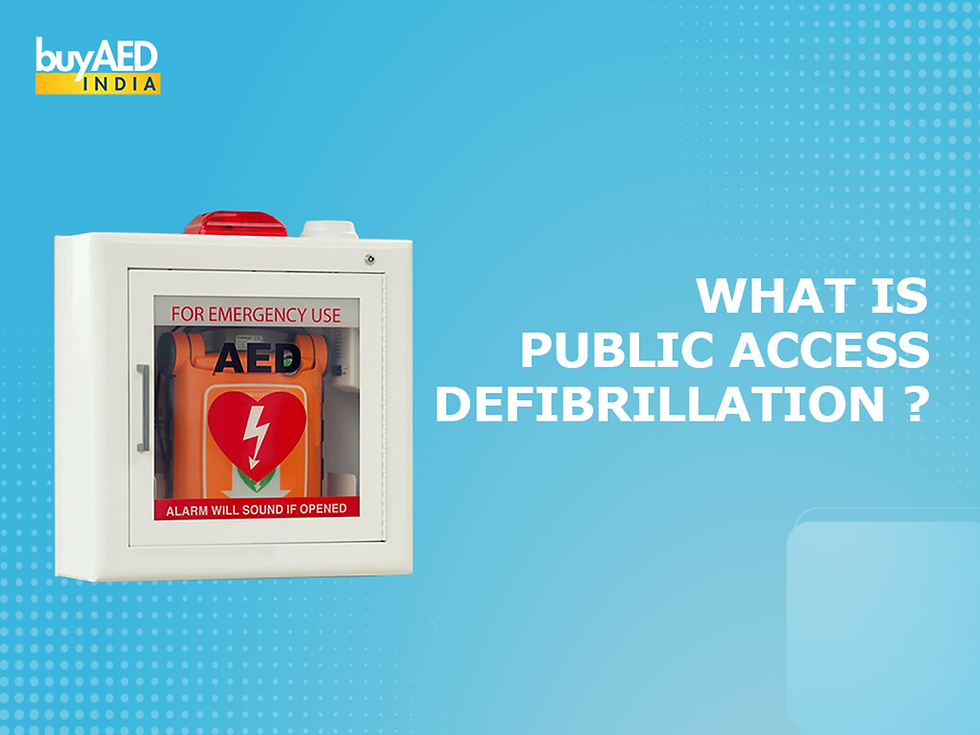Who can use an AED?
- Dr. Shruti Shah

- Jun 15
- 7 min read
Updated: Jul 28

Every year, thousands of people suffer from sudden cardiac arrest (SCA) outside hospitals.
An Automated External Defibrillator (AED) can make all the difference in these critical moments between life and death.
But many are left asking: Who can use an AED?
The short answer?
Anyone.
Yes, that is correct. Anyone without prior medical training is capable of using an AED. You don’t need to be a doctor, nurse, or paramedic to use an AED.
These life-saving devices are designed to be user-friendly, even for those with no medical training.
In this comprehensive guide, we’ll explore:
What an AED is and how it works
Who is legally allowed to use an AED
Step-by-step instructions on how to operate one
Why AEDs should be more accessible in public spaces
By the end, you’ll feel empowered knowing that you could be the reason someone survives a cardiac arrest.
What is an AED, and how does it work?
Automated External Defibrillators (AEDs) are portable medical devices designed to administer an electric shock to the heart in cases of sudden cardiac arrest (SCA).
SCA occurs when the electrical system of the heart malfunctions, leading to irregular heartbeat (ventricular fibrillation) or complete stoppage of circulation.
An AED analyzes heart rhythm and instructs its user to administer shock therapy to restore normal heartbeat.
The sooner an AED is used, the higher their chance of survival for their victims.
Key Features of an AED:
Voice and visual prompts: Guides users through each step.
Automated analysis: Determines if a shock is needed.
Safety mechanisms: Prevents accidental shocks.
Lightweight and portable: Can be used in emergencies anywhere.
Who is legally allowed to use an AED?
One of the largest misconceptions surrounding AEDs is that only medical professionals are capable of using them.
This is simply not true!
1. General Public
AEDs are designed for general public use, making them accessible even without formal training. Their user-friendly device provides clear step-by-step instructions that make misuse unlikely.
2. Workplace & School Personnel
Businesses, schools and public venues typically keep AEDs available on-site for use during emergency situations.
Employees or staff members are frequently encouraged (or even required) to receive basic AED and CPR training – although even untrained personnel may use an AED in an emergency situation.
3. First Responders (Police, Firefighters, Lifeguards)
Professional AED users receive formal training; however, they use the same AED models available to the general public. Their faster response times make the device work the same way for everyone.
4. Healthcare Providers
Doctors, nurses and paramedics have advanced life support (ALS) training; however, in many situations they use AEDs just like members of the general public would. This is especially prevalent when operating outside hospital environments.
When should you use an AED?
You should always read your AED’s user manual first for detailed instructions, but here’s a general rule:
Use an AED only when the person is unresponsive and not breathing properly.
It can sometimes be hard to tell if someone is breathing normally, especially if you’re not a medical professional. That’s why it’s a good idea to learn how to check for signs of proper breathing.
Modern AEDs come with smart features. Once you place the pads on the person’s chest, the machine will check their heart rhythm and only give a shock if it’s needed meaning the person is in cardiac arrest. Because of this, even people with little or no training can use an AED safely.
When should you not use an AED?
Even though AEDs are designed to be simple and safe for anyone to use (some studies show even untrained kids can use them!), they are not toys and must be used properly.
Never use an AED on someone who is awake or responsive.
If the person is conscious, alert, and talking or moving, they do not need an electric shock. In fact, using an AED on a conscious person can be harmful.
In short:
Use an AED on someone who is unresponsive and not breathing properly
Do not use it on someone who is awake or breathing normally
Step-by-Step to Use an AED (Even Without Training)

If someone suddenly collapses and becomes unresponsive, it could be due to a cardiac arrest or a life-threatening emergency.
Acting quickly and confidently can help save their life. Even if you are not trained, follow these simple steps:
1. Check for Responsiveness
Approach the person safely and try to wake them up.
Gently shake their shoulders and speak loudly, saying something like, “Are you okay?” Look for any signs of movement, breathing, or response.
If the person does not respond at all, treat it as an emergency.
Immediately call 112 or your local emergency number for help. If someone is nearby, ask them to make the call while you stay with the victim.
2. Begin CPR
If the person is not breathing or only gasping, start CPR (Cardiopulmonary Resuscitation) right away.
Place the heel of one hand in the center of their chest and the other hand on top. Push hard and fast, compressing the chest at a rate of 100 to 120 compressions per minute. Let the chest rise completely between compressions.
If you are not trained in giving rescue breaths, just do hands-only CPR and focus on chest compressions until help arrives or an AED is available.
3. Retrieve and Turn On the AED
Ask someone nearby to bring the Automated External Defibrillator (AED) as quickly as possible.
AEDs are commonly found in airports, shopping malls, gyms, offices, schools, and public buildings.
Once you have the AED, turn it on immediately. Some models turn on automatically when you open the lid. The device will start giving you clear voice prompts to guide you.
4. Attach the AED Pads
Expose the person’s bare chest. If the chest is wet or sweaty, wipe it dry with a cloth or the provided towel in the AED kit.
Take the two adhesive pads from the AED. Place one pad on the upper right side of the chest, just below the collarbone.
Place the second pad on the lower left side, a few inches below the armpit. This placement allows the electrical shock to pass through the heart effectively.
If the victim is a child and the AED has pediatric pads, use those instead. They are designed to deliver a lower-energy shock suitable for children.
5. Let the AED Analyze the Heart Rhythm
Once the pads are in place, the AED will automatically start analyzing the person's heart rhythm.
It’s crucial that no one is touching the person during this time, as it can interfere with the analysis.
The AED will tell you what to do next, whether a shock is needed or not.
6. Deliver the Shock (If Advised)
If the AED advises a shock, it will say something like, “Shock advised. Stay clear of the patient.”
Before pressing the shock button, make sure no one is in contact with the person. Loudly say, “Everyone stands clear,” and visually check that no one is touching the victim.
Then press the shock button when prompted. The AED will deliver a controlled electrical shock to the person’s heart to try to restore a normal rhythm.
7. Resume CPR
After the shock is delivered (or if no shock is advised), the AED will instruct you to resume CPR immediately.
Continue giving chest compressions for another 2 minutes, following the same rate and depth as before. The AED will reanalyze the heart rhythm after each
Can you use an AED for Children?
Yes! Most AEDs come with pediatric pads or a setting that adjusts the shock intensity for children under 8 or weighing less than 55 lbs.
If no pediatric setting is available, using an adult AED is still better than doing nothing.
How Much do AEDs Cost in India?
Buying a defibrillator (AED) can feel like a big investment, but over the years, the prices have become more affordable.
In the early days, even the most basic AED used to cost more than ₹3 lakhs, which made it too expensive for many companies and organizations.
Thankfully, with better technology and more availability, AEDs are now much more budget-friendly.
At Buy AED India, you can find AEDs starting from around ₹50,000 and going up to ₹3 lakhs, depending on the features you need.
For example, do you want an AED that gives voice instructions in multiple languages? Or one that can be used for both adults and children?
These features can affect the price.
Other factors that can influence the cost include:
The energy level the AED delivers (shock power)
Whether it has a display screen or not
The length of the warranty
Battery life and how often you need to replace the electrode pads
It’s a good idea to talk to an expert who can explain the features and help you pick the right AED based on your needs.
Popular AED Brands and Their Price Ranges in India:
Philips AED – ₹1,05,000 to ₹2,50,000
Zoll AED – ₹1,58,000 to ₹2,82,000
Cardiac Science Powerheart AED – ₹1,19,999 to ₹2,60,999
Defibtech AED – ₹1,12,000 to ₹2,00,000
Allied Medical – ₹1,02,000 to ₹1,64,000
Mediana AED – ₹1,05,000 to ₹1,49,000
AEDs are life-saving tools and getting the right one for your home, office, school, or public space can make a huge difference in an emergency.
Let me know if you want help comparing models or choosing the best one for your needs!
Conclusion
An AED (Automated External Defibrillator) is a powerful tool that can save lives and the best part is anyone can use it.
You don't need to be a doctor or medical expert. These machines are made to be simple, safe, and easy to follow, even during an emergency.
Whether you're at home, at school, or in a shopping mall, using an AED quickly on someone who is unresponsive and not breathing properly can double or triple their chance of survival.
So don’t be afraid to step in and follow the steps, and you might just be the hero someone needs.
If you're considering getting an AED, especially in India, they are now more affordable than ever and come in many models to suit different needs. It's a smart and caring decision for any home, office, or public place.
FAQs
1. Can a normal person use an AED?
Yes! AEDs are made for everyone even if you’ve never used one before. The machine talks you through each step.
2. Do I need training to use an AED?
No, training helps, but it’s not required. AEDs are automatic and safe. Just turn it on and follow the instructions.
3. Can I hurt someone by using an AED?
No. AEDs only give a shock if the person needs it. You can’t shock someone by mistake.
4. Can I use an AED on a child?
Yes. Most AEDs have special child pads or settings. But if you don’t have them, it’s still okay to use adult pads.
5. Where can I buy an AED in India and how much does it cost?
You can buy AEDs from trusted platforms like BuyAEDIndia. Prices usually start around ₹50,000 and go up depending on features.
If you are confused about finding one that offers both quality and affordability, don’t forget to check out defibrillators from Buy AED India, which offers Philips Defibrillators, ZOLL Defibrillators, Cardiac Science Defibrillators, and Defibtech Defibrillators that will meet your needs.





Comments